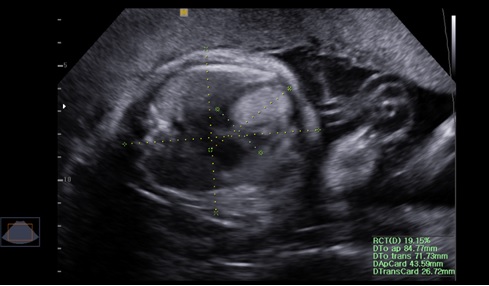Tuberous sclerosis: Prenatal diagnosis, treatment and one-year follow-up. A case report
Main Article Content
Abstract
Background: Tuberous sclerosis, occurring in approximately 2 % of pediatric tumors, leads to anomalous masses in various organs (retina, skin, lungs, kidneys, heart, and nervous system). Cardiac rhabdomyomas and brain lesions, causing heart failure and seizures, have shown improvement with Everolimus, a cell growth inhibitor. Case report: We present a one-year-old girl with tuberous sclerosis, cardiac rhabdomyomas, and subependymal astrocytoma. The treatments were Everolimus to reduce the lesions. After one year of follow-up, the cardiac and brain lesions decreased in the echocardiograms and MRI, but presences of the arrhytmias (right bundle branch block) were managed with metoprolol and seizures were treated with phenobarbital. No renal or ophthalmological involvement was evident during the one year of follow up. Conclusion: The Everolimus treatment (an m-TOR inhibitor) reduces cardiac rhabdomyomas and subependymal astrocytoma in tuberous sclerosis, marking progress in pediatric management.
Downloads
Article Details

This work is licensed under a Creative Commons Attribution-NonCommercial-NoDerivatives 4.0 International License.
Creative Commons
License Attribution-NonCommercial-ShareAlike 4.0 International (CC BY-NC-SA 4.0)
You are free to:
Share - copy and redistribute the material in any medium or format.
Adapt - remix, transform, and build upon the material The licensor cannot revoke these freedoms as long as you follow the license terms.
• Attribution — You must give appropriate credit, provide a link to the license, and indicate if changes were made. You may do so in any reasonable manner, but not in any way that suggests the licensor endorses you or your use.
• NonCommercial — You may not use the material for commercial purposes.
• ShareAlike — If you remix, transform, or build upon the material, you must distribute your contributions under the same license as the original.
• No additional restrictions — You may not apply legal terms or technological measures that legally restrict others from doing anything the license permits.
References
Thatte NM, Guleserian KJ, Surendranath R, Reddy V. New-onset cardiac rhabdomyoma beyond infancy in a patient with tuberous sclerosis complex. Cardiol Young. 2016;26:396-399.
Betancourth Alvarenga F, Vázquez Rueda A, Escassi Gil JI, Garrido Pérez V, Vargas Cruz R, Paredes Esteban RM. Neonatal tumors: experience in a Pediatric Oncology Unit. Cir Pediatr. 2018;31:94-98.
Jaramillo Daza JF, Cruz Osorio V. Rabdomioma fetal: diagnóstico prenatal y tratamiento. Rev Col Cardiol. 2016;23(5):424.e1-454.e5.
Wilbur C, Sanguansermsri C, Chable H, Anghelina M, Peinhof S, Anderson K, et al. Manifestations of Tuberous Sclerosis Complex: The Experience of a Provincial Clinic. Can J Neurol Sci. 2017;44:35-43.
Juárez-García LC, Mendoza-Celaya J, Flores-Gallegos L, López-Félix J, Casillas-Barrera M, Leis-Márquez T, et al. Fetal cardiac tumors: importance of prenatal diagnosis and perinatal repercussions. Ginecol Obstet Mex. 2018;86(3):193-199.
Franz DN, Agricola K, Mays M, Tudor C, Care MM, Holland-Bouley K, et al. Everolimus for Subependymal Giant Cell Astrocytoma: 5-Year Final Analysis. Ann Neurol. 2015;78:929-938.
Anaya-Reyes P, Rodríguez-Rábago MJ. Diagnóstico prenatal de rabdomioma cardiaco. Reporte de un caso. Gineco Obstet Mex. 2013;81:477-481.
Arango Posada CA. Rabdomiomas cardíacos y esclerosis tuberosa: presentación de dos casos en recién nacidos. Arch Med. 2012;12(2):199-204.
Medina-Malo C, Carreño O, Vélez A, Lizcano LA, Ortiz LD, Becerra H, et al. Tuberous sclerosis complex. Acta Neurol Colomb. 2012;28:11-23.
Riveros Moron, Bilbao la Vieja H, Suárez Imaña, Ballón, Parra Nigañez, Hurtado F. Intracardiac rhabdomyosarcoma: a case report. Rev Soc Bol Ped. 2013;52(2):87-89.
Recio Rodríguez M, Cano Alonso R, López Azorín M, Carrascoso Herranz J, Martín Fernández-Mayoralas D, Tamarit Degenhardt I. Importance of fetal MRI in the early diagnosis of tuberous sclerosis. Soc Esp Radiol Méd. 2018. Educational electronic presentation.
Costales D, Medici C, Cerisola A, Costa G, Turcati E, Dufort G, et al. First experience with everolimus treatment in a patient with tuberous sclerosis and subependymal giant cell astrocytoma in Uruguay. Arch Med Int. 2015;37(3):150-153. Available at: http://www.scielo.edu.uy/scielo.php?script=sci_arttext&pid=S1688-423X2015000300011&lng=es.
Zapata-Tarrés M, Ibarra-Ríos D, Cruz-Rodríguez IV, Juárez-Villegas LE, Peña-del Castillo H. Malignant neoplasms in the neonate. Bol Med Hosp Infant Mex. 2014;71(5):261-270.
Vela Pinedo P, León Alcántara C. Esclerosis Tuberosa. Rev Exp Med. 2016;2(1):32-34.
López NV, Rodríguez GR, Vegas G, De La Calle M, González G A. Fetal cardiac tumors: ultrasound diagnosis, evolution, and treatment. Rev Chil Obst Ginecol. 2011;76(3):147-154.
Zhao X, Zhao X, Wei H, Jin F. Tuberous sclerosis complex with left ventricular noncompaction: a case description. Quant Imaging Med Surg 2022;12(5):2995-2999. doi: 10.21037/qims-21-834
Portocarrero LKL, Quental KN, Samorano LP, Oliveira ZNP, Rivitti-Machado MCDM. Tuberous sclerosis complex: review based on new diagnostic criteria. An Bras Dermatol. 2018 Jun;93(3):323-331. doi: 10.1590/abd1806-4841.20186972. PMID: 29924239; PMCID: PMC6001077.





